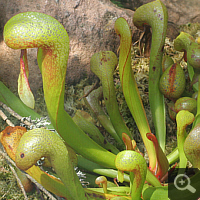Cobra Lily (Darlingtonia)
Overview
The Cobra Lily is a monotypic genus of the North American Pitcher Plant family. Like the North American Pitcher Plants the Cobra Lily is only to be found in North America. More precise formulated the distribution area of the Cobra Lily is restricted only to the border region between California and Oregon. There the Cobra Lily is to be found in two different habitats. On the one hand are locations in the mountains up to a height of over 3.000 m colonised, in addition – especially in Oregon – are also coastal biotops colonised. Both biotop types have in common that soil is drained by cool water. The Cobra Lily is a restant plant with a repent rhizome. From this arise numerous, green pitchers, which in their shape recall a cobra. The pitcher expands at the top end to a dome with transparent windows. The dome shows at the bottom in front of the pitcher an opening, before which a flat appendix is located, which looks like a split adder’s tongue. From the ground leads a wing rib upwards to the pitcher opening. In the case of small plants the pitchers rest on the ground and only the dome is upstanding, on the contrary larger plants produce complete upstanding pitchers, which in the case of old plants can reach a maximum height of 70 cm.
Trap mechanism
The principle trap mechanism was already detailed described on the previous site. Several mechanisms serve the attraction of insects. The pitchers are turned with their opening outward, so that the inscet catching is eased, the transparent windows in the zone of the dome feign an escape path. Both, the wing rib and the appendix produce nectar. The appendix should attract flying insects and serves them as landing spot. The wing rib serves besides mechanical stabilisation of the pitcher also as conductor rail for crawling insects, which are attracted directly to the pitcher opening. At this is an inwards overhanging bead located, which – just as it was trespassed – should block a way back. From the bead on the inner pitcher surface is smooth, so that insects can descend. Furthermore downward directed hairs hamper an escape.
Culture and propagation
The culture of the Cobra Lily is not quite trivial. The main problem in its culture poses the claim to a cooled root sytem analogous to its natural habitat along rivers, which run cool water from the mountains. I use as soil mainly peat with a slight addition of quartz sand and sphagnum moss within a large clay pot. I give this clay pot in a white cachepot, which has a circa three to four centimetres more in diameter. The space between both pots is filled with sphagnum moss. Watering is in permanent ebb and flood irrigation system. The white cachepot prevents a heating of root system, because this reflect completely solar radiation. Fatal would be a black culture pot, which would absorb solar radiation completely. The sphagnum moss in the intermediate space as well as on the culture soil evaporates water and led thus to a cooling of the root system. A water evaporation means energy withdrawal, what is tantamount to a cooling of the medium. Evaporation is energetic a potent method. Visualise, how long you ought to let a pot with one litre water boil on your cooker (and therefore feed energy, in other words electricity), before the water is evaporated completely. In winter keep the Cobra Lily at a light and cool place. The water supplies can be reduced significantly.

